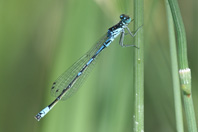Abstract
Two new species of Aporcelinus from Vietnamese natural habitats are studied, described and illustrated, including line drawings and light microscope (LM) pictures. Aporcelinus paramamillatus sp. n. is characterized by its 1.71–2.14 mm long body, lip region 21–22 μm broad, odontostyle 22–24 μm long at its ventral side, neck 451–503 μm long, uterus tripartite and 71–94 µm long, V = 53–54, tail conical with finely rounded tip, ending in a short peg-like terminus, occasionally slightly re-curved dorsad (24–34 μm, c = 50–77, c’ = 0.6–0.9) and unknown male. Aporcelinus paraseychellensis sp. n. is distinguished by its 1.20–1.46 mm long body, lip region 16–18 μm broad, odontostyle 20 μm long at its ventral side, neck 354–368 μm long, uterus tripartite and 176–241 µm long, V = 52–54, tail conical with acute tip and hardly re-curved dorsad, spicules 62 μm long, and 12 regularly spaced ventromedian supplements lacking hiatus.
References
Álvarez-Ortega, S. & Peña-Santiago, R. (2011) Studies on the genus Aporcelaimellus Heyns, 1965 (Dorylaimida: Aporcelaimidae). Species from Sri Lanka originally studied by Loos. Nematology, 13, 193–209.
http://dx.doi.org/10.1163/138855410X513213
Álvarez-Ortega, S. & Peña-Santiago, R. (2013) Taxonomy of the genus Aporcelaimellus Heyns, 1965 (Nematoda, Dorylaimida, Aporcelaimidae). Zootaxa, 3669 (3), 243–260.
http://dx.doi.org/10.11646/zootaxa.3669.3.3Álvarez-Ortega, S., Nguyen, T.A.D., Abolafia, J., Vu, T.T.T. & Peña-Santiago, R. (2015) Three new species of the genus Aporcelaimoides Heyns, 1965 from Vietnam (Nematoda, Dorylaimida, Aporcelaimidae), with an updated taxonomy of the genus. Zookeys, 516, 1–26.
http://dx.doi.org/10.3897/zookeys.516.10087Andrássy, I. (1959) Taxonomische Uebersicht der Dorylaimen (Nematoda). I. Acta Zoologica Academiae Scientiarum Hungaricae, 5, 191–240.
Andrássy, I. (1986) The genus Eudorylaimus Andrássy, 1959 and the present status of its species (Nematoda: Qudsianematidae). Opuscula Zoologica Budapestinensis, 22, 1–42.
Andrássy, I. (2009a) Aporcelinus, a new genus of aporcelaimoid nematodes (Dorylaimida), and its species. International Journal of Nematology, 19, 121–136.
Andrássy, I. (2009b) Another species of the genus Aporcelinus Andrássy, 2009 (Nematoda: Dorylaimida). Opuscula Zoologica Budapestinensis, 40, 99–102.
Andrássy, I. (2011) Phylum Nematoda. In: Gerlach, J. (Ed.), Crustacea, Platyhelminthes, Nematoda, Annelida and Tardigrada of the Seychelles Islands: 15–57. Siri Scientific Press, Manchester. 160 pp.
Andrássy, I. (2012) Two new species of the family Aporcelaimidae (Nematoda. Dorylaimida). Genus, 23, 189–199.
Baermann, G. (1917) Eine einfache Methode zur Auffindung von Ankylostomum (Nematoden) Larven in Erdproben. Geneeskunding Tijdschrift voor Nederlandsch-Indië, 57, 131–137.
Flegg, J.J.M. (1967) Extraction of Xiphinema and Longidorus species from soil by a modification of Cobb's decanting and sieving technique. Annals of Applied Biology, 60, 429–437.
http://dx.doi.org/10.1111/j.1744-7348.1967.tb04497.xHeyns (1965) On the morphology and taxonomy of the Aporcelaimidae, a new family of dorylaimid nematodes. Entomology Memoirs Department of Agriculture Technical Services Republic of South Africa, nº 10, 1–51.
Jairajpuri, M.S. (1965) Qudsianema amabilis n. gen., n. sp. (Nematoda: Dorylaimoidea) from India. Proceedings of the Helminthological Society of Washington, 32, 72–73.
Loof, P.A.A. & Coomans, A. (1970) On the development and location of the oesophageal gland nuclei in Dorylaimina. Proceedings of the IX International Nematology Symposium (Warsaw, Poland, 1967), 79–161.
Peña-Santiago, R., Abolafia, J. & Álvarez-Ortega, S. (2014) New proposal for a detailed description of the dorylaim spicule (Nematoda: Dorylaimida). Nematology, 16, 1091–1095.
http://dx.doi.org/10.1163/15685411-00002834Siddiqi, M.R. (1964) Studies on Discolaimus spp. (Nematoda: Dorylaimidae) from India. Zeitschrift für Zoologische Systematik und Evolutionsforschung, 2, 174–184.
Vinciguerra, M.T., Orselli, L. & Clausi, M. (2014) One new and two known species of Aporcelinus Andrássy, 2009 and a new species of Coomansinema Ahmad & Jairajpuri, 1989 (Nematoda: Dorylaimida). Nematology, 16, 303–322.
http://dx.doi.org/10.1163/15685411-00002767Vu, T.T., Ciobanu, M., Abolafia, J. & Peña-Santiago, R. (2010) Two remarkable new species of the genus Crassolabium Yeates, 1967 from Vietnam (Nematoda: Dorylaimida: Qudsianematidae). Journal of Natural History, 44, 2049–2064.
http://dx.doi.org/10.1080/00222933.2010.481055Williams, J.R. (1959) Studies on the nematode soil fauna of sugarcane fields in Mauritius. 3. Dorylaimidae (Dorylaimoidea, Enoplida). Mauritius Sugar Industry Research Institute Occasional Paper, 3, 1–28.

